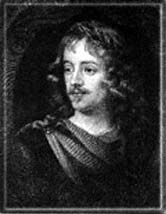 |
Suckling was born at Whitton, between Twickenham and Hounslow, Middlesex, on February 10, 1609. His mother died when the boy was four years of age, in 1613. His father, descendant of a prominent Norfolk family, was appointed Comptroller of James I's household in 1622. Suckling matriculated at Trinity College, Cambridge in 1623 but left without taking a degree in 1626. Suckling inherited extensive estates on his father's death in 1626, and was admitted to Gray's Inn in 1627. Just eighteen years old, he pursued a military and ambassadorial career in the Low Countries, and joined the English soldiers serving in the army of Gustavus Adolphus during the Thirty Years' War. Suckling was knighted in September 1630. He returned to the English court in May, 1632, where he became very popular through his wealth and charm. He was known as a gamester, and is credited with having invented the game of cribbage. In 1637, Suckling wrote the prose work Account of Religion by Reason. His play, Aglaura, was published in 1638 and performed twice for Charles I. The play had two different endings, one tragic and one happy. It was not a critical success, but it introduced the wonderful lyric poem "Why so pale and wan, fond lover?" In the same year, Suckling's comedy The Goblins was published. It was much influenced by Shakespeare's The Tempest and is generally thought to be Suckling's best. In 1639, Suckling recruited and equipped cavalry to help King Charles I in his first Scottish war. He was ridiculed in London for the troops' scarlet uniforms and plumed hats, but he was well-favored by the King. In 1640, Suckling sat in Parliament for Bramber and took part in an unsuccessful action against the Scots. In May, 1641, Suckling took an acitve part in the royalist plot to rescue Strafford from the Tower. When Parliament ordered him to account for his movements, Suckling fled through Dieppe to Paris. He died in Paris a few months later, in 1642, either from suicide by poison, or, as another tradition has it, by the hand of a servant who placed a razor in his boot. Most of Suckling's work first appeared posthumously in Fragmenta Aurea of 1646. Suckling's treated poetry casually, as a pastime, never commiting himself to serious study of literature, and as a result, his poetry suffers from irregularity. Suckling never attached himself to any school of poetry in particular. While his friend, Carew, was a disciple of Jonson, Suckling wrote disparagingly of Jonson both in the Sessions of the Poets and the unfinished drama, The Sad One. He was more inclined in the direction of Donne's style, with its elaborate metaphors and explosive passion. Poems such as Love's World, Farewell to Love, and Sonnet III are most reminiscent of Donne. Yet Suckling's poetry lacks the depth of feeling; he seems to have prided himself on its absence. In poems like Ballad upon a Wedding and 'Love, Reason, Hate,' Suckling approaches Herrick. As Thomas Crofts writes: “Suckling's verse, of course, smacks of the court: it is witty, decorous, sometimes naughty; all requisites for the courtier poet. But these qualities alone would not have sufficed to "perpetuate his memory." It should be remembered that the court swarmed with now-forgotten versifiers. Suckling had his own voice, a deft conversational ease mixed at times with a certain hauteur or swagger, which qualities were not incompatible with his high birth and military occupation.... Though his oeuvre is comparatively small, Suckling is an exemplary lyric poet, as well as one of the most vivid personalities of his age.” 2
 Article Citation: Jokinen, Anniina. "The Life of Sir John Suckling." Luminarium. 27 Mar 2003. [Date you accessed this article]. <http://www.luminarium.org/sevenlit/suckling/sjsbio.htm>  Suckling | Works | Resources | Essays | Cavalier Poets | 17th C. Lit
Site copyright ©1996-2006 Anniina Jokinen. All Rights Reserved. Created by Anniina Jokinen on November 15, 1997. Last updated on June 8, 2006.
|
 "Suckling, above all the other
"Suckling, above all the other 